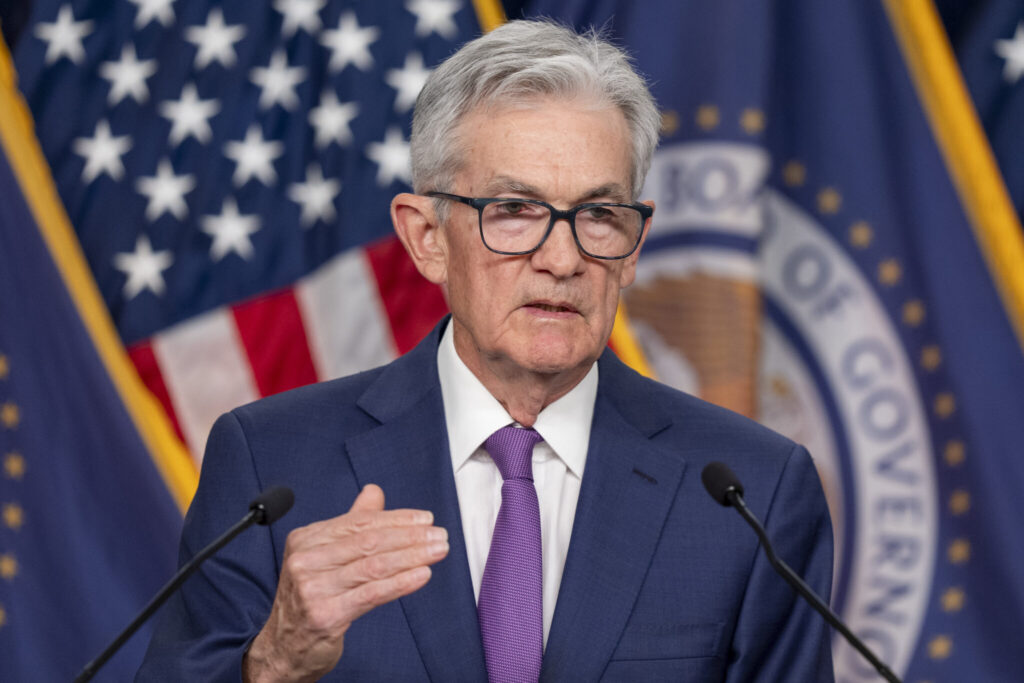Federal Reserve Chair Jerome Powell said Tuesday that the central bank is unlikely to raise its key interest rate in response to signs of stubborn inflation and underscored his view that price increases would soon start to cool again.
Quick Read
- Federal Reserve Chair Jerome Powell has indicated that a rate hike is unlikely in response to current inflation pressures, expressing confidence that price increases will soon begin to cool, despite acknowledging that inflation has been hotter than expected in early 2024.
- During a discussion in Amsterdam, Powell stated the Fed is more inclined to maintain the current high benchmark rate rather than increase it, citing mixed economic signals, including some cooling in specific sectors like airfares and car insurance.
- Powell downplayed the significance of recent wholesale inflation figures, suggesting that while some areas show price increases, the overall inflation data is mixed. He remains hopeful that inflation will revert closer to the Fed’s 2% target soon.
- The Fed chair also highlighted that certain persistent factors, like rising rents, continue to prop up inflation rates, but he anticipates these will eventually align with broader trends showing cooling prices.
The Associated Press has the story:
Fed’s Powell downplays potential for a rate hike despite higher price pressures
Newslooks- WASHINGTON (AP) —
Federal Reserve Chair Jerome Powell said Tuesday that the central bank is unlikely to raise its key interest rate in response to signs of stubborn inflation and underscored his view that price increases would soon start to cool again.
Yet Powell, during a panel discussion in Amsterdam, said his confidence that inflation will ease “is not as high as it was” because price increases have been persistently hot in the first three months of this year. Powell stressed that the Fed’s preferred approach was to keep its benchmark rate at its current two-decade peak rather than increase it.
“I don’t think that it’s likely, based on the data that we have, that the next move that we make would be a rate hike,” Powell said. “I think it’s more likely that we’ll be at a place where we hold the policy rate where it is.”
Financial markets and economists have been hoping for signs that one or two Fed rate cuts might be coming this year, given that inflation is down sharply from its high in 2022. But with price pressures still elevated, Powell and other Fed officials have signaled that no rate cut is likely anytime soon.
Powell spoke hours after a report on U.S. producer prices showed that wholesale inflation picked up in April. On Wednesday, the government will issue the latest monthly report on consumer inflation, which is expected to show that price growth cooled a bit last month.
In his remarks Tuesday, Powell downplayed the wholesale price report, which also showed that some costs cooled last month, including for airfares, hospital visits and car insurance.
“I wouldn’t call it hot,” he said of the wholesale inflation data. “I would call it sort of mixed.”
Economists are divided over whether the high inflation figures this year reflect a re-acceleration in price growth or are largely echoes of pandemic distortions. Auto insurance, for example, has soared 22% from a year ago, but that surge may reflect factors specific to the auto industry: New car prices jumped during the pandemic, and insurance companies are now seeking to offset the higher repair and replacement costs by raising their premiums.
Other economists point to consistent consumer spending on restaurant meals, travel and entertainment, categories where in some cases price increases have also been elevated, possibly reflecting strong demand.
Powell said that upcoming inflation reports will reveal whether such factors are keeping inflation high or whether inflation will soon fall back to the Fed’s 2% target, as he said he expects. Inflation, which peaked at 9.1% in the summer of 2022, is forecast to slow to 3.4% in Wednesday’s latest report.
The Fed chair noted that rising rents are one key factor keeping inflation high. He called that “a bit of a puzzle” because measures of new apartment leases show new rents barely increasing. Such weaker data has apparently yet to flow into the government’s measures, which cover all rents, including for tenants who renew their leases. Though rents are still growing faster for tenants who renew leases, Powell said the government’s measures should eventually show rent growth easing.
The Fed chair also acknowledged that the economy “is different this time” because so many Americans refinanced their mortgages at very low rates before the Fed began raising borrowing costs in March 2022. Many large businesses also locked in low rates at that time.
“It may be,” he said, that the Fed’s rate policy “is hitting the economy not quite as strongly as it would have if those two things were not the case.”
Last week, Fed officials underscored that they were prepared to leave their key interest rate at 5.3%, the highest level in 23 years, as long as needed quell inflation.







